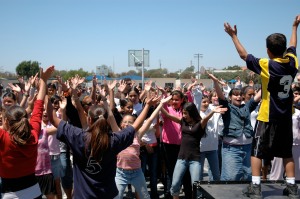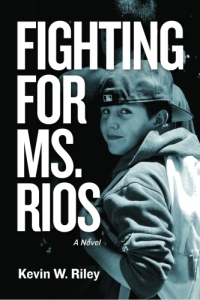 We are two weeks from the 2009 iteration of the California Standards Test. The clock is ticking. We are prepared. We are in a zone. And we better be…considering the high stakes.
We are two weeks from the 2009 iteration of the California Standards Test. The clock is ticking. We are prepared. We are in a zone. And we better be…considering the high stakes.
High stakes? Isn’t that just residual hyperbole left over from the NCLB-era politics? Well let’s check it out.
Here are a dozen ways that standardized testing has resulted in high “stakes” outcomes and their unintended consequences:
• High stakes because the results are going to follow every student for the remainder of their school careers.
• High stakes because schools will use the results to determine students’ eligibility for after-school programs and tutoring opportunities and Advanced Placement classes and extracurricular activities. Even for eligibility (and thus in-eligibility) for participation in athletics and the performing arts.
• High stakes because school officials will use the scores as a criteria for classifying children as gifted– public education’s most coveted label. Similarly, they will cite these scores when diagnosing children as learning disabled.
• High stakes because schools will (illegally) weigh the portents of these scores before admitting new students. Or they will consult them– the final straw– before expelling or disenrolling kids; before recommending ‘delinquents’ to a continuation program or independent study or homeschooling or some other version of learning in Siberia.
In high stakes testing, the results matter to everybody.

• They are “high stakes” because presidents and governors and mayors run for elected office on the promise of improving local trends in standardized test scores. School board members too. And the superintendents that school boards hire will survive on their ability to deliver higher scores on metrics like the Academic Performance Index (API). Likewise the principals that the superintendents hire will come and go like bad wind and pretty much everybody will feel the pressure when the next wave of leaders are clearing out their desks and insuring their colleagues that they have always wanted to return to the classroom.
• High stakes because that pressure to raise test scores will drive teachers with the most seniority (and experience) toward the schools with the higher API (800+) and lower stress levels.
 • High stakes because schools with low API’s (<700) will continue to replace those migrating veteran teachers with brand new inexperienced teachers who will take five years to learn their craft… and then they will migrate too. And while they are learning, those younger teachers will be just starting to raise families of their own. So you can expect those teachers to be out two to three months on maternity leave and to be temporarily replaced by long-term substitute teachers who have less training and less experience than the inexperienced young teacher they are replacing.
• High stakes because schools with low API’s (<700) will continue to replace those migrating veteran teachers with brand new inexperienced teachers who will take five years to learn their craft… and then they will migrate too. And while they are learning, those younger teachers will be just starting to raise families of their own. So you can expect those teachers to be out two to three months on maternity leave and to be temporarily replaced by long-term substitute teachers who have less training and less experience than the inexperienced young teacher they are replacing.
And the community will witness the invisible forces of the high stakes tests in ways they could never imagine.
• High stakes because when educated, upwardly mobile young couples start looking for a suitable neighborhood in which to raise their families they inevitably consider the quality of the schools. They consult websites like greatschools.net and identify the school districts with the highest test scores. And that is where they buy their home.

• High stakes because when large groups of young, upwardly mobile couples get together to raise their children, they insist on state of the art pre-schools and they start volunteering in the elementary school before their kids are old enough to walk. So a whole community evolves around a culture of high achievement. It becomes pre-ordained and the Academic Performance Index of the schools go even higher.
• High stakes because the schools with low API’s struggle for any organizational momentum at all. They tend to serve families who are less educated and thus less upwardly mobile. They tend to serve families that are in survival mode. They do not tend to attract the new young families who just moved to town and who are looking for the very best schools.
• High stakes because the communities with large clusters of well educated and upwardly mobile families experience far fewer home foreclosures than those where families took greater risks with loans. (In San Diego County, for example, the top five zip codes with the highest number of home foreclosures featured schools with an average API of only 754.) Home foreclosures lead to higher student mobility rates as families migrate toward more affordable housing options.
High stakes.
 • High stakes because we are all compelled to strike hard against the mountainous challenge of quantifying children’s learning on the basis of a single standardized test. We will balance the winners and the losers and the inevitable damage caused when the best of intentions collide with unintentional consequences. And that is, by definition, high stakes– where our systems align poorly or not at all. And for that incongruence…our children pay.
• High stakes because we are all compelled to strike hard against the mountainous challenge of quantifying children’s learning on the basis of a single standardized test. We will balance the winners and the losers and the inevitable damage caused when the best of intentions collide with unintentional consequences. And that is, by definition, high stakes– where our systems align poorly or not at all. And for that incongruence…our children pay.
In California, there are only two weeks remaining until we administer the next version of the CST. When it is complete, we will dutifully send our thousand student answer sheets off to Sacramento with a blind faith that they will be accurately scored. And the cycle of waiting for the results and the early analyses will begin anew.
Our students are ready to play the game. It is high stakes. We are “all in”.
 A new study from the Center for Research and Reform in Education at John Hopkins University has concluded that “Spanish-speaking children learn to read English equally well regardless of whether they are taught primarily in English or in both English and their native language.”
A new study from the Center for Research and Reform in Education at John Hopkins University has concluded that “Spanish-speaking children learn to read English equally well regardless of whether they are taught primarily in English or in both English and their native language.” We have always said that it’s the quality of the teaching and the passion for promoting biliteracy that makes the difference!!!
We have always said that it’s the quality of the teaching and the passion for promoting biliteracy that makes the difference!!!











 This is the
This is the  It is the first day of school and so our students return. It is mid-summer… most school districts will not call their students back until after Labor Day. Not El Milagro, though. We start early. So ready or not, they are are descending– in droves. Record high enrollment and a long waiting list means business is good.
It is the first day of school and so our students return. It is mid-summer… most school districts will not call their students back until after Labor Day. Not El Milagro, though. We start early. So ready or not, they are are descending– in droves. Record high enrollment and a long waiting list means business is good. The Nature Center is our reminder that we are out of whatever “the box” is and our students could be the beneficiaries.
The Nature Center is our reminder that we are out of whatever “the box” is and our students could be the beneficiaries.  • SECOND: Beyond basic skills, we would work just as hard to provide a more authentic, thinking curriculum that allows children to discover their natural gifts and interests. A curriculum that features the interesting stuff that engages students every day. Like the Nature Center and all its wind-framed beauty and ocean air; its banks of slippery seaweed, its deep fish tanks that stink. Or the tidepools, tucked snugly up against shallow marshes that splash mud and seawater on kid’s school clothes when the tide is up. Or rare creatures on loan from their fragile ecosystems; sometimes strange life-forms that can make kids smile when they hold them in their hands.
• SECOND: Beyond basic skills, we would work just as hard to provide a more authentic, thinking curriculum that allows children to discover their natural gifts and interests. A curriculum that features the interesting stuff that engages students every day. Like the Nature Center and all its wind-framed beauty and ocean air; its banks of slippery seaweed, its deep fish tanks that stink. Or the tidepools, tucked snugly up against shallow marshes that splash mud and seawater on kid’s school clothes when the tide is up. Or rare creatures on loan from their fragile ecosystems; sometimes strange life-forms that can make kids smile when they hold them in their hands.
 We are two weeks from the 2009 iteration of the California Standards Test. The clock is ticking. We are prepared. We are in a zone. And we better be…considering the high stakes.
We are two weeks from the 2009 iteration of the California Standards Test. The clock is ticking. We are prepared. We are in a zone. And we better be…considering the high stakes.
 • High stakes because schools with low API’s (<700) will continue to replace those migrating veteran teachers with brand new inexperienced teachers who will take five years to learn their craft… and then they will migrate too. And while they are learning, those younger teachers will be just starting to raise families of their own. So you can expect those teachers to be out two to three months on maternity leave and to be temporarily replaced by long-term substitute teachers who have less training and less experience than the inexperienced young teacher they are replacing.
• High stakes because schools with low API’s (<700) will continue to replace those migrating veteran teachers with brand new inexperienced teachers who will take five years to learn their craft… and then they will migrate too. And while they are learning, those younger teachers will be just starting to raise families of their own. So you can expect those teachers to be out two to three months on maternity leave and to be temporarily replaced by long-term substitute teachers who have less training and less experience than the inexperienced young teacher they are replacing.
 • High stakes because we are all compelled to strike hard against the mountainous challenge of quantifying children’s learning on the basis of a single standardized test. We will balance the winners and the losers and the inevitable damage caused when the best of intentions collide with unintentional consequences. And that is, by definition, high stakes– where our systems align poorly or not at all. And for that incongruence…our children pay.
• High stakes because we are all compelled to strike hard against the mountainous challenge of quantifying children’s learning on the basis of a single standardized test. We will balance the winners and the losers and the inevitable damage caused when the best of intentions collide with unintentional consequences. And that is, by definition, high stakes– where our systems align poorly or not at all. And for that incongruence…our children pay.




